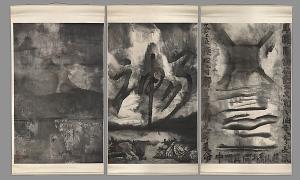Gu Wenda
Gu Wenda
Place: Shanghai
Born: 1955
Biography:
, a renowned contemporary artist from China, was born in 1955 in Shanghai. His artistic journey is marked by an innovative approach to traditional Chinese calligraphy and ink painting, often incorporating human hair into his works.
Early Life and Education
Gu's early life was influenced by his family's background in banking and wool production. His paternal grandfather, an actor, introduced the spoken word into traditionally sung Chinese theatre, which had a significant impact on Gu's future artistic endeavors. During the Cultural Revolution, Gu's grandparents were taken away for "reeducation," resulting in the loss of many artistic documents and objects. Gu aspired to become one of the Red Guards and eventually succeeded. As a member of the Guards, he worked to simplify the Chinese language and encourage new attitudes towards old traditions. This period marked the beginning of his interest in traditional calligraphy, which would later play a major role in his artworks. He was also taught woodcarving but found it to be a strictly practical exercise devoid of real creativity.
Career
Gu's career began with a series of projects centered on the invention of meaningless, false Chinese ideograms. One exhibition in Xi'an in 1986, featuring paintings of fake ideograms on a massive scale, was shut down by authorities who assumed it carried a subversive message. The exhibit was later allowed to re-open for professional artists only. After waiting for a student visa for five years, Gu came to the United States in 1987 and eventually moved to New York. He put his art work aside for a year while learning English and served as an artist-in-residence at the University of Minnesota. Turning from his work on language, Gu developed an interest in bodily materials and understanding humanity through hair and other substances. United Nations Project, a collection of works focusing on hair, was exhibited in the Baker-Berry Library at Dartmouth College for four months. This project showcases Gu's innovative approach to exploring human connection across ethnic and national boundaries.
Artistic Style and Significance
Gu's artistic style is characterized by his use of traditional Chinese calligraphy and ink painting, often combined with modern techniques. His works, such as Mythos of Lost Dynasties Series—Negative and Positive Characters, demonstrate his mastery of combining traditional and contemporary elements. Traditional Chinese Calligraphy plays a significant role in Gu's artworks, reflecting his deep understanding of the cultural heritage and history of China. His use of human hair adds a unique dimension to his works, exploring the complexities of language, culture, and history.
- Gu Wenda's artistic journey is marked by innovation and experimentation.
- His use of traditional Chinese calligraphy and ink painting reflects his deep understanding of Chinese cultural heritage.
- United Nations Project showcases Gu's unique approach to exploring human connection across ethnic and national boundaries.
- Gu's artistic style is characterized by the combination of traditional and contemporary elements.
In conclusion, Gu Wenda's biography is a testament to his innovative approach to traditional Chinese calligraphy and ink painting. His use of human hair and bodily materials adds a unique dimension to his works, making him a significant figure in the contemporary art world. For more information on Gu Wenda's artworks, visit Gu Wenda.





